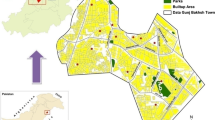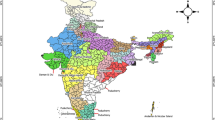Abstract
Crime is a critical issue that has gained significant attention in many countries including Malaysia. The Malaysian government has invested in a system known as the Geographical Information System (GIS) to map the crime hotspots in high prospect zones. However, the occurrences of violent crimes continue to increase at an alarming rate despite the implementation of the system. In order to combat crimes in a more effective manner in recent years, crime mapping has been proposed to identify crime hotspots in the country. This study applies crime mapping to identify crime hotspots in Malaysia. Data on crime for 14 states in Malaysia from 2007–2016 were obtained, with permission, from the Royal Malaysia Police or known as Police DiRaja Malaysia (PDRM) in Bahasa Malaysia. Data visualization was carried out using Tableau to gain more insights on the patterns and behaviours from violent crime data. The results show that Selangor has the highest number of violent crimes, followed by Kuala Lumpur and Johor. Perlis has the lowest number of violent crimes. Gang robbery is the highest in all 14 states. Interestingly, violent crimes being the highest in Selangor which also has the highest youth population. There is also a strong significant positive correlation between number of violent crime and youth population.
Access this chapter
Tax calculation will be finalised at checkout
Purchases are for personal use only
Similar content being viewed by others
References
Zakaria, S., Rahman, N.A.: The mapping of spatial patterns of property crime in Malaysia: normal mixture model approach. J. Bus. Soc. Dev. 4(1), 1–11 (2016)
Ishak, S.: Perceptions of people on police efficiency and crime prevention in urban areas in Malaysia. Econ. World 4(5), 243–248 (2016). https://doi.org/10.17265/2328-7144/2016.05.005
Muhammad Amin, B., Mohammad Rahim, K., Geshina Ayu, M.S.: A trend analysis of violent crimes in Malaysia. Health 5(2), 41–56 (2014)
Performance Management and Delivery Unit (PEMANDU). GTP Annual Report 2010 (2010). https://www.pemandu.gov.my/assets/publications/annual-reports/GTP_2010_EN.pdf
Habibullah, M.S., Baharom, A.H., Muhamad, S.: Crime and police personnel in Malaysia: an empirical investigation. Taylor’s Bus. Rev. (TBR) 4(2), 1–17 (2014)
Overseas Security Advisory Council. Malaysia 2015 Crime and Safety Report (2015). https://www.osac.gov/pages/ContentReportDetails.aspx?cid=17215
Sidhu, A.S.: The rise of crime in Malaysia: an academic and statistical analysis. J. Kuala Lumpur R. Malays. Police Coll. 4, 1–28 (2005)
Overseas Security Advisory Council. Malaysia 2016 Crime and Safety Report (2016). https://www.osac.gov/pages/ContentReportDetails.aspx?cid=19182
Nelson, A.L., Bromley, R.D., Thomas, C.J.: Identifying micro-spatial and temporal patterns of violent crime and disorder in the British city centre. Appl. Geogr. 21(3), 249–274 (2001)
Zainol, R., Yunus, F., Nordin, N.A., Maidin, S.L.: Empowering Community Neighborhood Watch with Crime Monitoring System using Web-Based GIS, 1–10 (2011)
Foon Tang, C.: An exploration of dynamic relationship between tourist arrivals, inflation, unemployment and crime rates in Malaysia. Int. J. Soc. Econ. 38(1), 50–69 (2011)
Levine, N.: Crime mapping and the crimestat program. Geogr. Anal. 38(1), 41–56 (2006). https://doi.org/10.1111/j.0016-7363.2005.00673
Salleh, S.A., Mansor, N.S., Yusoff, Z., Nasir, R.A.: The crime ecology: ambient temperature vs. spatial setting of crime (Burglary). Procedia - Soc. Behav. Sci. 42, 212–222 (2012)
Murray, A.T., McGuffog, I., Western, J.S., Mullins, P.: Exploratory spatial data analysis techniques for examining urban crime. Br. J. Criminol. 41(2), 309–329 (2001). https://doi.org/10.1093/bjc/41.2.309
Bakri, M., Abidin, Siti Z.Z., Shargabi, A.: Incremental filtering visualization of JobStreet Malaysia ICT jobs. In: Mohamed, A., Berry, Michael W., Yap, B.W. (eds.) SCDS 2017. CCIS, vol. 788, pp. 188–196. Springer, Singapore (2017). https://doi.org/10.1007/978-981-10-7242-0_16
Idrus, Z., Abdullah, N.A.S., Zainuddin, H., Ja’afar, A.D.M.: Software application for analyzing photovoltaic module panel temperature in relation to climate factors. In: Mohamed, A., Berry, Michael W., Yap, B.W. (eds.) SCDS 2017. CCIS, vol. 788, pp. 197–208. Springer, Singapore (2017). https://doi.org/10.1007/978-981-10-7242-0_17
Abdullah, N.A.S., Wahid, N.W.A., Idrus, Z.: Budget visual: malaysia budget visualization. In: Mohamed, A., Berry, Michael W., Yap, B.W. (eds.) SCDS 2017. CCIS, vol. 788, pp. 209–218. Springer, Singapore (2017). https://doi.org/10.1007/978-981-10-7242-0_18
Rosli, N.A., Mohamed, A., Khan, R.: Visualisation enhancement of HoloCatT matrix. In: Badioze Zaman, H., Robinson, P., Petrou, M., Olivier, P., Schröder, H., Shih, Timothy K. (eds.) IVIC 2009. LNCS, vol. 5857, pp. 675–685. Springer, Heidelberg (2009). https://doi.org/10.1007/978-3-642-05036-7_64
Van Schaaik, J.G., Van Der Kemp, J.J.: Real crimes on virtual maps: the application of geography and GIS in criminology. In: Scholten, H.J., van de Velde, R., van Manen, N. (eds.) Geospatial Technology and the Role of Location in Science, pp. 217–237. Springer, Heidelberg (2009). https://doi.org/10.1007/978-90-481-2620-0_12
Asmai, S.A., Roslin, N.I.A., Abdullah, R.W., Ahmad, S.: Predictive crime mapping model using association rule mining for crime analysis. Age 12, 21 (2014)
Boba, R.: Introductory Guide to Crime Analysis and Mapping, 74 (2001). http://www.ncjrs.gov/App/abstractdb/AbstractDBDetails.aspx?id=194685
Peddle, D.R., Ferguson, D.T.: Optimisation of multisource data analysis: an example using evidential reasoning for GIS data classification. Comput. Geosci. 28(1), 45–52 (2002)
Markovic, J., Stone, C.: Crime Mapping and the Policing of Democratic Societies. Vera Institute of Justice, New York (2002)
Chainey, S., Ratcliffe, J.: GIS and Crime Mapping. Wiley, Wiley (2013)
Abdullah, M.A., Abdullah, S.N.H.S., Nordin, M.J.: Smart City Security: Predicting the Next Location of Crime Using Geographical Information System With Machine Learning. Asia Geospatial Forum Malaysia Asia Geospatial Forum, September 2013, pp. 24–26 (2013)
Dunham, R.G., Alpert, G.P.: Critical Issues in Policing: Contemporary readings. Waveland Press, Long Grove (2015)
Johnson, C.P.: Crime Mapping and Analysis Using GIS. In: Conference on Geomatics in Electronic Governance, Geomatics 2000, pp. 1–5, January 2000
Bailey, T.C., Gatrell, A.C.: Interactive Spatial Data Analysis, vol. 413. Longman Scientific & Technical, Essex (1995)
Chainey, S., Reid, S., Stuart, N.: When is a hotspot a hotspot? A procedure for creating statistically robust hotspot maps of crime, pp. 21–36. Taylor & Francis, London (2002)
Eck, J., Chainey, S., Cameron, J., Wilson, R.: Mapping crime: understanding hotspots (2005)
Williamson, D., et al.: Tools in the spatial analysis of crime. Mapp. Anal. Crime Data: Lessons Res. Pract. 187 (2001)
Pallant, J.: SPSS Survival Manual. McGraw-Hill Education, New York City (2013)
Cohen, L., Manion, L., Morrison, K.: Research Methods in Education. Routledge, Abingdon (2013)
Triola, M.F., Franklin, L.A.: Business Statistics. Addison-Wesley, Publishing Company, Inc., Abingdon (1994)
Acknowledgement
We would like to thank the Polis DiRaja Malaysia (PDRM) for the permission to use the crime data for academic purpose, we are also grateful to the Research Management Centre (RMC) UiTM for the financial support under the university Research Entity Initiatives Grant (600-RMI/DANA 5/3/REI (16/2015)).
Author information
Authors and Affiliations
Corresponding author
Editor information
Editors and Affiliations
Rights and permissions
Copyright information
© 2019 Springer Nature Singapore Pte Ltd.
About this paper
Cite this paper
Anuar, N.B., Yap, B.W. (2019). Data Visualization of Violent Crime Hotspots in Malaysia. In: Yap, B., Mohamed, A., Berry, M. (eds) Soft Computing in Data Science. SCDS 2018. Communications in Computer and Information Science, vol 937. Springer, Singapore. https://doi.org/10.1007/978-981-13-3441-2_27
Download citation
DOI: https://doi.org/10.1007/978-981-13-3441-2_27
Published:
Publisher Name: Springer, Singapore
Print ISBN: 978-981-13-3440-5
Online ISBN: 978-981-13-3441-2
eBook Packages: Computer ScienceComputer Science (R0)




